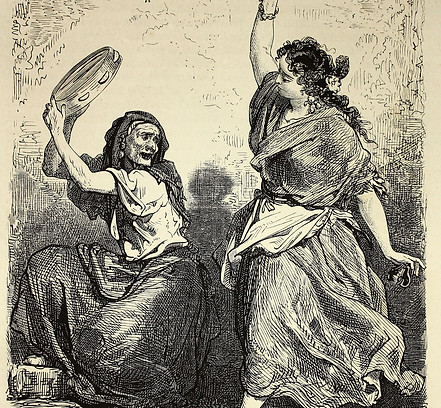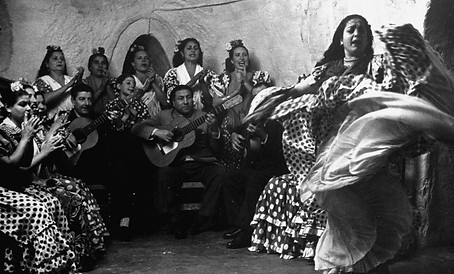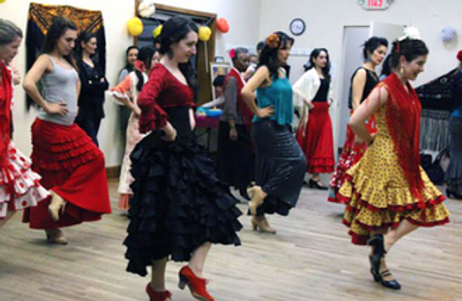
Home
Migration Stories and Demographics of Flamenco
By Lalia, Emily, Jaycey, Casey, & Kaylah
Despite the distortion of its original form throughout history, it is known that the flamenco dance originated in Andalucia, Spain during the period of the nation’s Arab reign. It was marked by the arrival of the gypsies (gitanos) upon the Iberian Peninsula during the fifteenth century after having traveled throughout India, Iran, and Egypt. Following a prolonged three-century period of oppression by the monarchs, the Romantic era (the late eighteenth century into the early nineteenth century) of Europe gave flamenco the opportunity to blossom and enjoy commercial popularity, as the spotlight was focused on all things exotic and emotional. The contained familial practice amongst “outsiders” was then expanded.


From 1765 to 1860, the first flamenco dance schools were established in Triana (present day Seville) and Cadiz, Jerez de la Frontera, inciting the growing presence of the dance form in ballrooms. It was not until the Golden Age of Flamenco (1869-1910) - in which the genre was introduced in musical cafés (cafés cantantes) as a form of entertainment - that it began to develop into its currently known style, gaining its characteristic guitar accompaniment. As flamenco was introduced to the world stage, discrepancies arose about purity of the dance form as ballerinas were even seen incorporating the new “Spanish art” movements into their own form in a spin-off of the gypsy style known as ópera flamenca. However, it was this meshing with elite and aristocratic culture that further developed the concert performance aspect of the genre. With the Spanish dictator - Francisco Franco’s - decision to make flamenco the country’s national dance, the form became a vehicle for propaganda, as films about the dance lured tourists in with the same exotic zeal enjoyed during the Romantic era.
Originally practiced within circles of nomadic gypsy families and communities at their camps, the traditional dance of flamenco was passed down rather than taught as it is in present day. Through its cultural assimilation in Europe, the style began to gain more prestige, and in doing so, began to be taught as an art form for professional artists, predominantly in Spain. Both men and women dance flamenco, oftentimes together as a show of sensuality, and sometimes apart as soloists to showcase individual feminine and masculine charm. Women tend to exude a certain flirtatiousness in their movements, kicking their long tail-like skirts up, and giving extra attention to the sensitivity in their spiraling hand gestures. Men typically convey a more proud, assertive tone in their dancing with their harsh stomps and sharp shoulder movements. In recognizing this, it is evident that although the dance style has evolved throughout its many years of practice, traditional gender roles still remain in attempts to portray the “natural order” between man and woman; this trace of antiquity can be accredited to Spain’s extensive Catholic presence.


At present, flamenco classes are available mainly on the northside of Chicago at established dance academies, indicating that the majority of people who dance this form most likely live in the north. The dance form is popular in this area due to it being rich in culture and history. The northside of Chicago is where the more affluent communities of the city are located. Lessons can cost anywhere from $70 to $90 per hour, and it is difficult to find discounts on the popular savings site known as Groupon due to flamenco’s elevated social status. Therefore, those who do not take the classes for the purpose of performing, are most likely people with steady incomes who can afford to splurge on a class for the sake of exploring another culture. Working links to classes can be found on our homepage, under the "Links" tab.
Works Cited
-
Bennahum, Ninotchka Devorah. “Flamenco.” Encyclopædia Britannica, Encyclopædia Britannica, Inc., 8 May 2018, www.britannica.com/art/flamenco.
-
Cuellar-Moreno, Maria. “Flamenco Dance. Characteristics, Resources, and Reflections on Its Evolution.” Taylor & Francis Online, Lincoln Geraghty, 28 Nov. 2016, www.tandfonline.com/doi/full/10.1080/23311983.2016.1260825.
-
“Flamenco Classes & Events.” Flamenco Chicago, Flamenco Chicago, 2018, www.flamencochicago.com/flamenco-classes-events/.
-
“Flamenco History.” Todo Sobre Espa, INTERNET Red 2000, S.L, 2000, www.red2000.com/spain/flamenco/history.html.
-
Koller-Alonso, Paula. “The History Of Flamenco Dance.” Culture Trip, The Culture Trip Ltd. , 14 Feb. 2016, theculturetrip.com/europe/spain/articles/the-history-of-flamenco-dance/.
-
“What Is Flamenco Dancing?” Wonderopolis, National Center For Families Learning, 2014, wonderopolis.org/wonder/what-is-flamenco-dancing.
7. “2018 Fall Session.” Clinard Dance, Squarespace, 2018, www.clinardance.org/new-products/.